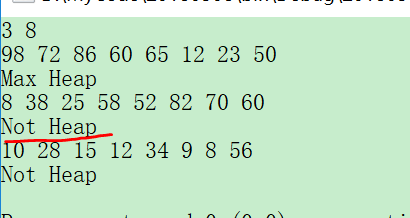1147 Heaps(30 分)
In computer science, a heap is a specialized tree-based data structure that satisfies the heap property: if P is a parent node of C, then the key (the value) of P is either greater than or equal to (in a max heap) or less than or equal to (in a min heap) the key of C. A common implementation of a heap is the binary heap, in which the tree is a complete binary tree. (Quoted from Wikipedia at https://en.wikipedia.org/wiki/Heap_(data_structure))
Your job is to tell if a given complete binary tree is a heap.
Input Specification:
Each input file contains one test case. For each case, the first line gives two positive integers: M (≤ 100), the number of trees to be tested; and N (1 < N ≤ 1,000), the number of keys in each tree, respectively. Then M lines follow, each contains N distinct integer keys (all in the range of int), which gives the level order traversal sequence of a complete binary tree.
Output Specification:
For each given tree, print in a line Max Heap if it is a max heap, or Min Heap for a min heap, or Not Heap if it is not a heap at all. Then in the next line print the tree's postorder traversal sequence. All the numbers are separated by a space, and there must no extra space at the beginning or the end of the line.
Sample Input:
3 8
98 72 86 60 65 12 23 50
8 38 25 58 52 82 70 60
10 28 15 12 34 9 8 56
Sample Output:
Max Heap
50 60 65 72 12 23 86 98
Min Heap
60 58 52 38 82 70 25 8
Not Heap
56 12 34 28 9 8 15 10题目大意:输入几组完全二叉树的层次遍历序列,判断它是最大堆、最小堆、还是啥都不是。树中节点数N<=1000
//如果只判断是不是堆,完全不用建树,因为是完全二叉树可以利用数组下标,左子树下标为2*i,右子树是2*i+1。然而最终都要给出来后根遍历,所以建树再后根遍历还是比较方便的。
//怎么根据层次遍历建树呢?不会也。。。

#include <iostream> #include <string> #include <vector> #include<cstdio> using namespace std; int main() { int k,n; cin>>k>>n; while(k--){ vector<int> tree(n+1); for(int i=1;i<=n;i++){ cin>>tree[i]; } bool flag=true; for(int i=1;2*i<=n||2*i+1<=n;i++){//判断是否是最大堆 if(tree[i]>=tree[2*i]&&tree[i]>=tree[2*i+1])continue; else{ flag=false;break; } } if(flag)cout<<"Max Heap "; else{ flag=true; for(int i=1;2*i<=n||2*i+1<=n;i++){ if(tree[i]<=tree[2*i]&&tree[i]<=tree[2*i+1])continue; else{ flag=false;break; } } if(flag)cout<<"Min Heap "; else cout<<"Not Heap "; } } return 0; }
写出的这个代码在运行样例的时候,出现了以下问题:

第二个最小堆,判断不是最小堆,突然发现是因为代码里,寻址了不存在的单元!这样的话那个单元是一个很大的负值,那么最大堆当然是可以判断了,但是最小堆就出现了问题!
//那如果那样去判断的话,可就是很复杂了。。。放弃。
//看到大佬28行的代码,内心是震惊的。。
代码来自:https://www.liuchuo.net/archives/4667
#include <iostream> #include <vector> using namespace std; int m, n; vector<int> v; void postOrder(int index) {//原来可以根据下标遍历完全二叉树啊! if (index >= n) return; postOrder(index * 2 + 1); postOrder(index * 2 + 2);//就算index * 2 + 2那么就会return,正好是递归出口。 printf("%d%s", v[index], index == 0 ? " " : " "); //如果遍历到最终根节点即index=0,那么 } int main() { scanf("%d%d", &m, &n); v.resize(n);//其实完全可以只用一个向量,因为新输入的会将原来的覆盖。 for (int i = 0; i < m; i++) { for (int j = 0; j < n; j++) scanf("%d", &v[j]); int flag = v[0] > v[1] ? 1 : -1;//根据这个判断可能的情况。 for (int j = 0; j <= (n-1) / 2; j++) {//原来可以这样限制j的范围。 int left = j * 2 + 1, right = j * 2 + 2; //因为只有右边的会超,所以只控制右边即可。 //厉害了,反过来进行判断。 if (flag == 1 && (v[j] < v[left] || (right < n && v[j] < v[right]))) flag = 0; if (flag == -1 && (v[j] > v[left] || (right < n && v[j] > v[right]))) flag = 0; } if (flag == 0) printf("Not Heap "); else printf("%s Heap ", flag == 1 ? "Max" : "Min");//这一句厉害厉害。 postOrder(0); } return 0; }
//真是太厉害了,再判断是否是堆以及后根遍历的时候,我还需要时间消化
